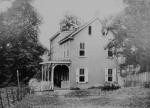Historic RittenhouseTown
Introduction
Text-to-speech Audio
Images
Abraham Rittenhouse home, late 1800s, (Photo Courtesy of the Historic Rittenhouse Town)

Backstory and Context
Text-to-speech Audio
From the early 18th century, Rittenhouse Street linked the early settlement at Germantown with RittenhouseTown and brought a constant stream of people, horses and wagons into the community past the Homestead on their way to the mill across the Paper Mill Run. Weavers transformed flax grown in Germantown into linen textiles and when the fabric was reduced to rags it was brought to RittenhouseTown to be made into paper. Paper produced at the Rittenhouse mill was sold to printers in nearby Germantown, Philadelphia and New York for use in Bibles and newspapers.
As the Rittenhouse family expanded so did the village of RittenhouseTown. In later years, the Baptist Chapel located just yards from the Homestead’s front door welcomed mill workers who lived in the tenement building directly across Rittenhouse Street. By the mid 19th century, over 40 buildings populated this busy self contained industrial village including numerous residences for family members and mill workers, several mills producing paper, textiles, rugs, and blankets or grinding grain, a school, firehouse, general store and smithy. Until the construction of the Walnut Lane Bridge in 1908, Rittenhouse Street continued to be one of only a few routes linking Germantown with Roxborough, Manayunk and the Schuylkill River.1
